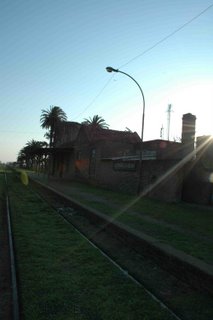 Does this outburst mean that the politicians of this country take finally conscience of the importance of the train in a country where the plane and the bus supplant it for a long time?Will it be enough to make up for lost time?
Does this outburst mean that the politicians of this country take finally conscience of the importance of the train in a country where the plane and the bus supplant it for a long time?Will it be enough to make up for lost time?  All had however started very well. On August 30, 1857, 32 years only after the startup of the first railway line of the world in England, Argentina inaugurated the line Buenos Aires- Floresta (10 kms). In 1880, it counted 2500 Kms from ways, 28000 in 1910, 40000 in 1930 and was placed then at the 3rd rank of the American continent behind the United States and Canada, holding 43% of the rail network of South America.
All had however started very well. On August 30, 1857, 32 years only after the startup of the first railway line of the world in England, Argentina inaugurated the line Buenos Aires- Floresta (10 kms). In 1880, it counted 2500 Kms from ways, 28000 in 1910, 40000 in 1930 and was placed then at the 3rd rank of the American continent behind the United States and Canada, holding 43% of the rail network of South America.  Paradoxically, it is this constructor frenzy which precipitated the decline of the train. British, French or American companies to which had been allotted various concessions, engaged in an unrestrained competition thus never acted in concert to set up a homogeneous network as for the width of the ways.
Paradoxically, it is this constructor frenzy which precipitated the decline of the train. British, French or American companies to which had been allotted various concessions, engaged in an unrestrained competition thus never acted in concert to set up a homogeneous network as for the width of the ways.  Was added to that the disinterest of the politicians after the 2nd world war. The travelling material became increasingly decayed and the network fell in fallow. The nationalization of the Argentinian railroads in 1965, ended with a chronic deficit representing more than 1% of the GDP. At the end of the Eighties, 55% of the ways were almost unusable.
Was added to that the disinterest of the politicians after the 2nd world war. The travelling material became increasingly decayed and the network fell in fallow. The nationalization of the Argentinian railroads in 1965, ended with a chronic deficit representing more than 1% of the GDP. At the end of the Eighties, 55% of the ways were almost unusable.  In 1991, the contrary decision was made, but privatization neither improved the state of the network nor that of the material. Some portions are today still in such a state (including in the Capital), that they oblige trains to roll in step to prevent that the ballast does not settle or that a bridge break down. Curiously however, the service continues, regular, punctual when it can be, to the last station of the last “pueblo” of the Pampa, for a long time unused…
In 1991, the contrary decision was made, but privatization neither improved the state of the network nor that of the material. Some portions are today still in such a state (including in the Capital), that they oblige trains to roll in step to prevent that the ballast does not settle or that a bridge break down. Curiously however, the service continues, regular, punctual when it can be, to the last station of the last “pueblo” of the Pampa, for a long time unused…Pictures of this article were taken at the village “Antonio Carboni”
No comments:
Post a Comment